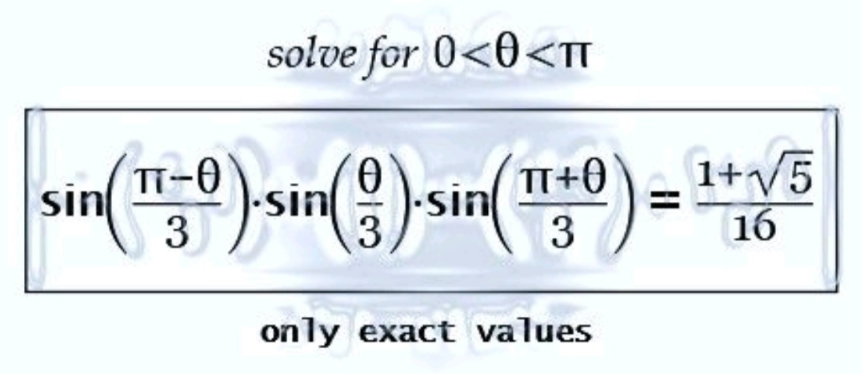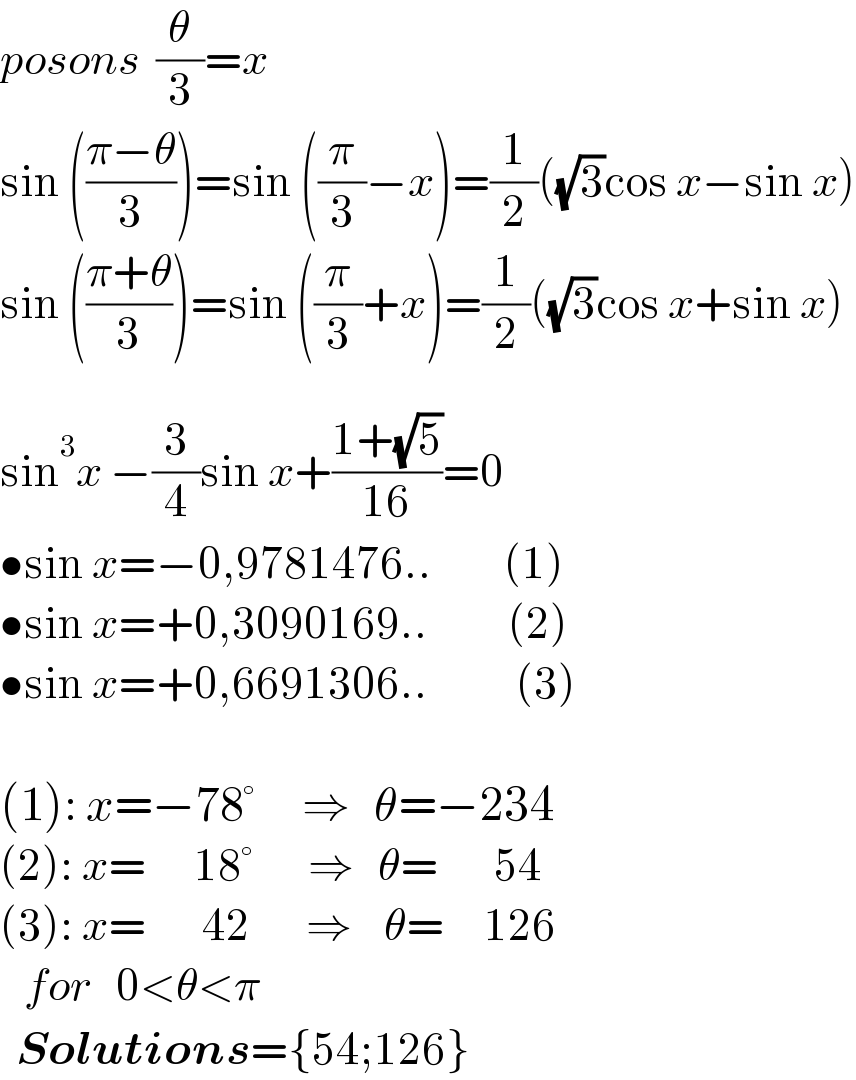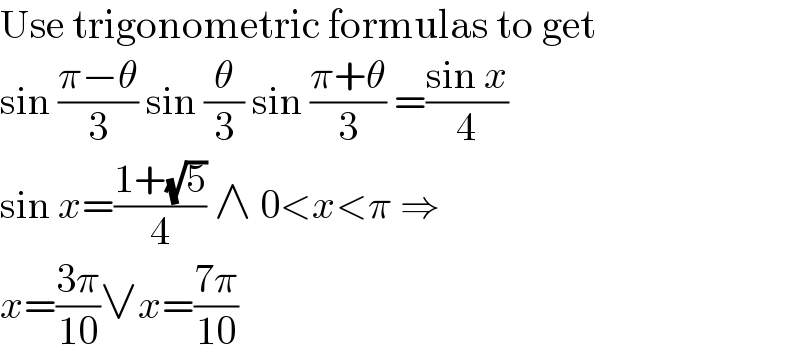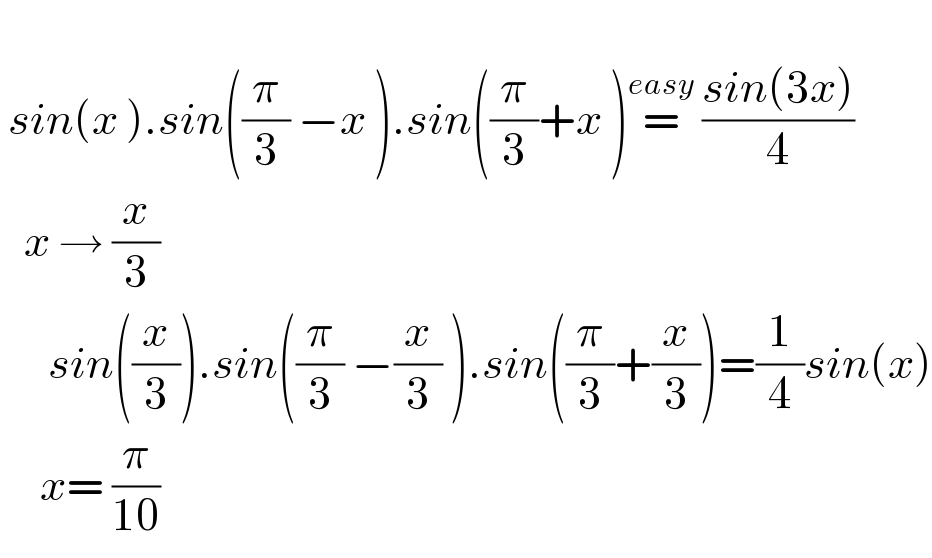
Question Number 188912 by Mingma last updated on 08/Mar/23

Answered by a.lgnaoui last updated on 09/Mar/23

$${posons}\:\:\frac{\theta}{\mathrm{3}}={x} \\ $$$$\mathrm{sin}\:\left(\frac{\pi−\theta}{\mathrm{3}}\right)=\mathrm{sin}\:\left(\frac{\pi}{\mathrm{3}}−{x}\right)=\frac{\mathrm{1}}{\mathrm{2}}\left(\sqrt{\mathrm{3}}\mathrm{cos}\:{x}−\mathrm{sin}\:{x}\right) \\ $$$$\mathrm{sin}\:\left(\frac{\pi+\theta}{\mathrm{3}}\right)=\mathrm{sin}\:\left(\frac{\pi}{\mathrm{3}}+{x}\right)=\frac{\mathrm{1}}{\mathrm{2}}\left(\sqrt{\mathrm{3}}\mathrm{cos}\:{x}+\mathrm{sin}\:{x}\right) \\ $$$$\:\: \\ $$$$\mathrm{sin}^{\mathrm{3}} {x}\:−\frac{\mathrm{3}}{\mathrm{4}}\mathrm{sin}\:{x}+\frac{\mathrm{1}+\sqrt{\mathrm{5}}}{\mathrm{16}}=\mathrm{0} \\ $$$$\bullet\mathrm{sin}\:{x}=−\mathrm{0},\mathrm{9781476}..\:\:\:\:\:\:\:\:\:\left(\mathrm{1}\right) \\ $$$$\bullet\mathrm{sin}\:{x}=+\mathrm{0},\mathrm{3090169}..\:\:\:\:\:\:\:\:\:\:\left(\mathrm{2}\right) \\ $$$$\bullet\mathrm{sin}\:{x}=+\mathrm{0},\mathrm{6691306}..\:\:\:\:\:\:\:\:\:\:\:\left(\mathrm{3}\right) \\ $$$$ \\ $$$$\left(\mathrm{1}\right):\:{x}=−\mathrm{78}°\:\:\:\:\:\:\Rightarrow\:\:\:\theta=−\mathrm{234} \\ $$$$\left(\mathrm{2}\right):\:{x}=\:\:\:\:\:\:\mathrm{18}°\:\:\:\:\:\:\:\Rightarrow\:\:\:\theta=\:\:\:\:\:\:\:\mathrm{54} \\ $$$$\left(\mathrm{3}\right):\:{x}=\:\:\:\:\:\:\:\mathrm{42}\:\:\:\:\:\:\:\Rightarrow\:\:\:\:\theta=\:\:\:\:\:\mathrm{126} \\ $$$$\:\:\:{for}\:\:\:\mathrm{0}<\theta<\pi \\ $$$$\:\:\boldsymbol{{Solutions}}=\left\{\mathrm{54};\mathrm{126}\right\}\:\: \\ $$
Commented by a.lgnaoui last updated on 08/Mar/23

Commented by Mingma last updated on 09/Mar/23
Excellent!
Answered by mr W last updated on 09/Mar/23
![recall sin α sin β=(1/2)[cos (α−β)−cos (α+β)] sin 3x=sin x(3−4 sin^2 x) sin 54°=sin ((3π)/(10))=((1+(√5))/4) let x=(θ/3) sin ((π/3)−x) sin ((π/3)+x) =(1/2)[cos (−2x)−cos ((2π)/3)] =(1/2)[cos (2x)+(1/2)] =(1/4)(3−4 sin^2 x) eqn. becomes to (1/4)(3−4 sin^2 x)sin x=((1+(√5))/(16)) (3−4 sin^2 x)sin x=((1+(√5))/4) sin 3x=((1+(√5))/4) sin θ=((1+(√5))/4) ⇒θ=nπ+(−1)^n sin^(−1) ((1+(√5))/4) ⇒θ=nπ+(((−1)^n 3π)/(10)) within 0<θ<π ⇒θ=((3π)/(10)) or ((7π)/(10)), i.e. 54° or 126°](Q188923.png)
$${recall}\: \\ $$$$\mathrm{sin}\:\alpha\:\mathrm{sin}\:\beta=\frac{\mathrm{1}}{\mathrm{2}}\left[\mathrm{cos}\:\left(\alpha−\beta\right)−\mathrm{cos}\:\left(\alpha+\beta\right)\right] \\ $$$$\mathrm{sin}\:\mathrm{3}{x}=\mathrm{sin}\:{x}\left(\mathrm{3}−\mathrm{4}\:\mathrm{sin}^{\mathrm{2}} \:{x}\right) \\ $$$$\mathrm{sin}\:\mathrm{54}°=\mathrm{sin}\:\frac{\mathrm{3}\pi}{\mathrm{10}}=\frac{\mathrm{1}+\sqrt{\mathrm{5}}}{\mathrm{4}} \\ $$$$ \\ $$$${let}\:{x}=\frac{\theta}{\mathrm{3}} \\ $$$$\mathrm{sin}\:\left(\frac{\pi}{\mathrm{3}}−{x}\right)\:\mathrm{sin}\:\left(\frac{\pi}{\mathrm{3}}+{x}\right) \\ $$$$=\frac{\mathrm{1}}{\mathrm{2}}\left[\mathrm{cos}\:\left(−\mathrm{2}{x}\right)−\mathrm{cos}\:\frac{\mathrm{2}\pi}{\mathrm{3}}\right] \\ $$$$=\frac{\mathrm{1}}{\mathrm{2}}\left[\mathrm{cos}\:\left(\mathrm{2}{x}\right)+\frac{\mathrm{1}}{\mathrm{2}}\right] \\ $$$$=\frac{\mathrm{1}}{\mathrm{4}}\left(\mathrm{3}−\mathrm{4}\:\mathrm{sin}^{\mathrm{2}} \:{x}\right) \\ $$$${eqn}.\:{becomes}\:{to} \\ $$$$\frac{\mathrm{1}}{\mathrm{4}}\left(\mathrm{3}−\mathrm{4}\:\mathrm{sin}^{\mathrm{2}} \:{x}\right)\mathrm{sin}\:{x}=\frac{\mathrm{1}+\sqrt{\mathrm{5}}}{\mathrm{16}} \\ $$$$\left(\mathrm{3}−\mathrm{4}\:\mathrm{sin}^{\mathrm{2}} \:{x}\right)\mathrm{sin}\:{x}=\frac{\mathrm{1}+\sqrt{\mathrm{5}}}{\mathrm{4}} \\ $$$$\mathrm{sin}\:\mathrm{3}{x}=\frac{\mathrm{1}+\sqrt{\mathrm{5}}}{\mathrm{4}} \\ $$$$\mathrm{sin}\:\theta=\frac{\mathrm{1}+\sqrt{\mathrm{5}}}{\mathrm{4}} \\ $$$$\Rightarrow\theta={n}\pi+\left(−\mathrm{1}\right)^{{n}} \:\mathrm{sin}^{−\mathrm{1}} \frac{\mathrm{1}+\sqrt{\mathrm{5}}}{\mathrm{4}} \\ $$$$\Rightarrow\theta={n}\pi+\frac{\left(−\mathrm{1}\right)^{{n}} \mathrm{3}\pi}{\mathrm{10}}\: \\ $$$${within}\:\mathrm{0}<\theta<\pi \\ $$$$\Rightarrow\theta=\frac{\mathrm{3}\pi}{\mathrm{10}}\:{or}\:\frac{\mathrm{7}\pi}{\mathrm{10}},\:{i}.{e}.\:\mathrm{54}°\:{or}\:\mathrm{126}° \\ $$
Commented by manxsol last updated on 09/Mar/23

$${Clear}\:{job}.\:{Perfect}! \\ $$
Answered by Frix last updated on 09/Mar/23

$$\mathrm{Use}\:\mathrm{trigonometric}\:\mathrm{formulas}\:\mathrm{to}\:\mathrm{get} \\ $$$$\mathrm{sin}\:\frac{\pi−\theta}{\mathrm{3}}\:\mathrm{sin}\:\frac{\theta}{\mathrm{3}}\:\mathrm{sin}\:\frac{\pi+\theta}{\mathrm{3}}\:=\frac{\mathrm{sin}\:{x}}{\mathrm{4}} \\ $$$$\mathrm{sin}\:{x}=\frac{\mathrm{1}+\sqrt{\mathrm{5}}}{\mathrm{4}}\:\wedge\:\mathrm{0}<{x}<\pi\:\Rightarrow \\ $$$${x}=\frac{\mathrm{3}\pi}{\mathrm{10}}\vee{x}=\frac{\mathrm{7}\pi}{\mathrm{10}} \\ $$
Answered by mnjuly1970 last updated on 09/Mar/23

$$ \\ $$$$\:{sin}\left({x}\:\right).{sin}\left(\frac{\pi}{\mathrm{3}}\:−{x}\:\right).{sin}\left(\frac{\pi}{\mathrm{3}}+{x}\:\right)\overset{{easy}} {=}\:\frac{{sin}\left(\mathrm{3}{x}\right)}{\mathrm{4}} \\ $$$$\:\:\:{x}\:\rightarrow\:\frac{{x}}{\mathrm{3}} \\ $$$$\:\:\:\:\:\:{sin}\left(\frac{{x}}{\mathrm{3}}\right).{sin}\left(\frac{\pi}{\mathrm{3}}\:−\frac{{x}}{\mathrm{3}}\:\right).{sin}\left(\frac{\pi}{\mathrm{3}}+\frac{{x}}{\mathrm{3}}\right)=\frac{\mathrm{1}}{\mathrm{4}}{sin}\left({x}\right) \\ $$$$\:\:\:\:\:{x}=\:\frac{\pi}{\mathrm{10}} \\ $$
